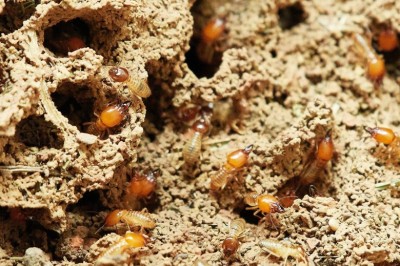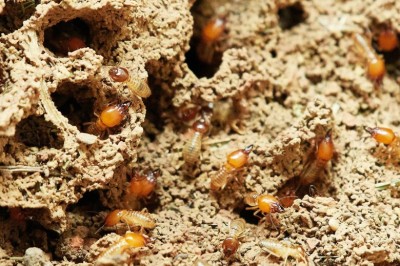Different Types Of Chemical Treatment For Termites
• Liquid Termiticide - Liquid termiticides are usually applied completely around and underneath a structure covering all areas where termites might gain access.
For new construction, this is accomplished by treating the graded soil before the slab is poured. For an existing building, the perimeter of the foundation is trenched and drilled then treated with termiticide.
The goal of the treatment is to put a chemical barrier between the termites in the soil and the structure above. The chemical barrier can also affect those termites inside a building by preventing their return to the soil. In many cases these termites will die of dehydration.
• Repellant Termiticide - There are several repellent termiticides on the market. These termiticides are all pyrethroids. Pyrethroids are fast acting nerve poisons that are highly toxic to termites but have low toxicity to mammals.
Some of the pyrethoid termite products include Dragnet FT, Cynoff, and Talstar (FMC Corporation, Philadelphia, PA) and Demon and Prelude (Syngenta, Inc., Greensboro, NC).
The pyrethroids are also highly repellent to termites. In most cases, they are so repellent that termites foraging under the soil will avoid coming into contact with the termiticide and forage elsewhere.
There are advantages and disadvantages to repellent termiticides. One advantage is that a complete barrier will effectively keep termites from coming into the structure. Also, the pyrethroids used for these barriers are relatively inexpensive and last for several years.
The disadvantage is that termites are able to detect this termiticide barrier in the soil and avoid lethal contact with them. This is important because applying a perfect barrier under a fully constructed house is very difficult.
Construction features, plumbing lines, and landscaping are just a few of the obstacles that hinder liquid termiticide application. Because of these difficulties, there are often gaps in the treatment where the termiticide was not applied completely.
Eventually, foraging termites may locate these gaps and gain access into the structure. If these termites find the structural wood, they will tunnel back through the untreated gap and recruit other termites into the building.
• Non-Repellant Termiticides - At the time of this writing there are two non-repellent termiticide treatments available on the commercial market. Both are nerve poisons like the pyrethroids, but they attack different sites on the nerve.
These chemicals are not repellant and termites cannot detect them in the soil. Therefore, the termites tunnel into the termiticide while foraging, contact the chemical, and die.
Premise (Bayer Corporation, Kansas City, MO.) contains the active ingredient imidocloprid. Imidocloprid is unique because it not only kills termites that contact a lethal dose, but it also kills them at doses too small to cause immediate death.
If a termite contacts even a very small amount of imidocloprid it will become lethargic and forget to eat and feed other termites. It will also forget to groom itself so it soon becomes infested with soil fungi.
The termite eventually dies as a result of these indirect symptoms of imidocloprid exposure. A disadvantage to Premise is that it is somewhat more expensive than the pyrethroid termiticides and in some cases may not last as long in the soil.
Termidor (Aventis Environmental Science, Montvale, NJ) is the newest termiticide on the market. Termidor became available in February 2000 for use as a non-repellent termiticide. The active ingredient is fipronil.
Fipronil is unique in that it can be transferred from one termite to another through contact and trophallaxis (communal feeding). This allows it to affect more termites than those that contact the chemical directly.
The advantage of this product is its long-term effectiveness in the soil. Test data indicate that fipronil may be effective longer after the initial application than other liquid termiticide products. A disadvantage is that Termidor is more expensive than other liquid termiticides.
For tips on termite extermination and termite prevention, visit the About Animals website.

























